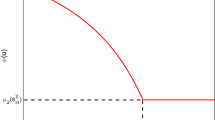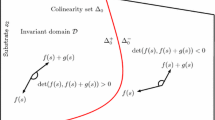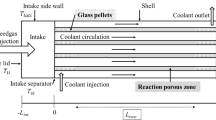Abstract
This paper presents an optimizing start-up strategy for a bio-methanator. The goal of the control strategy is to maximize the outflow rate of methane in anaerobic digestion processes, which can be described by a two-population model. The methodology relies on a thorough analysis of the system dynamics and involves the solution of two optimization problems: steady-state optimization for determining the optimal operating point and transient optimization. The latter is a classical optimal control problem, which can be solved using the maximum principle of Pontryagin. The proposed control law is of the bang–bang type. The process is driven from an initial state to a small neighborhood of the optimal steady state by switching the manipulated variable (dilution rate) from the minimum to the maximum value at a certain time instant. Then the dilution rate is set to the optimal value and the system settles down in the optimal steady state. This control law ensures the convergence of the system to the optimal steady state and substantially increases its stability region. The region of attraction of the steady state corresponding to maximum production of methane is considerably enlarged. In some cases, which are related to the possibility of selecting the minimum dilution rate below a certain level, the stability region of the optimal steady state equals the interior of the state space. Aside its efficiency, which is evaluated not only in terms of biogas production but also from the perspective of treatment of the organic load, the strategy is also characterized by simplicity, being thus appropriate for implementation in real-life systems. Another important advantage is its generality: this technique may be applied to any anaerobic digestion process, for which the acidogenesis and methanogenesis are, respectively, characterized by Monod and Haldane kinetics.






Similar content being viewed by others
References
Mailleret L, Bernard O, Steyer JP (2003) Robust regulation of anaerobic digestion processes. Water Sci Technol 48:87–94
Antonelli R, Harmand J, Steyer JP, Astolfi A (2003) Set-point regulation of an anaerobic digestion process with bounded output feedback. IEEE Trans Control Syst Technol 11:495–504
Méndez-Acosta HO, Palacios-Ruiz B, Alcaraz-González V, González-Álvarez V, García-Sandoval JP (2010) A robust control scheme to improve the stability of anaerobic digestion processes. J Process Control 20:375–383
Mailleret L, Bernard O, Steyer JP (2004) Nonlinear adaptive control for bioreactors with unknown kinetics. Automatica 40:1379–1385
Marcos NI, Guay M, Dochain D, Zhang T (2004) Adaptive extremum-seeking control of a continuous stirred tank bioreactor with Haldane’s kinetics. J Process Control 14:317–328
Dimitrova N, Krastanov M (2009) Nonlinear stabilizing control of an uncertain bioprocess model. Int J Appl Math Comput Sci 19:441–454
Steyer JP, Bernard O, Batstone D, Angelidaki I (2006) Lessons learnt from 15 years of ICA in anaerobic digesters. Water Sci Technol 53:25–33
Shen S, Premier GC, Guwy A, Dinsdale R (2007) Bifurcation and stability analysis of an anaerobic digestion model. Nonlinear Dyn 48:391–408
Hess J, Bernard O (2008) Design and study of a risk management criterion for an unstable anaerobic wastewater treatment process. J Process Control 18:71–79
Hess J, Bernard O (2009) Advanced dynamical risk analysis for monitoring anaerobic digestion process. Biotechnol Prog 25:643–653
Benyahia B, Sari T, Cherki B, Harmand J (2010) Equilibria of an anaerobic wastewater treatment process and their stability. In: Proceedings of the 11th international symposium on computer applications in biotechnology, Leuven, Belgium, pp 371–376
Logist F, Smets IY, Van Impe JF (2008) Derivation of generic optimal reference temperature profiles for steady-state exothermic jacketed tubular reactors. J Process Control 18:92–104
Logist F, Van Erdeghem PM, Van Impe JF (2009) Efficient deterministic multiple objective optimal control of (bio)chemical processes. Chem Eng Sci 64:2527–2538
Bernard O, Hadj-Sadok Z, Dochain D, Genovesi A, Steyer JP (2001) Dynamical model development and parameter identification for an anaerobic wastewater treatment process. Biotechnol Bioeng 75:424–438
Bastin G, Dochain D (1990) On-line estimation and adaptive control of bioreactors. Elsevier, Amsterdam
Sbarciog M, Loccufier M, Noldus E (2010) Determination of appropriate operating strategies for anaerobic digestion systems. Biochem Eng J 51:180–188
Sbarciog M, Loccufier M, Noldus E (2008) The computation of stability boundaries in state space for a class of biochemical engineering systems. J Comput Appl Math 215:557–567
García-Diéguez C, Molina F, Roca E (2011) Multi-objective cascade controller for an anaerobic digester. Proc Biochem 46:900–909
Banga JR, Balsa-Canto E, Moles CG, Alonso AA (2005) Dynamic optimization of bioprocesses: efficient and robust numerical strategies. J Biotechnol 117:407–419
Sbarciog M, Loccufier M, Noldus E (2008) Optimality and stability in a class of bang–bang controlled biochemical reaction systems. Int J Control 81:836–850
Sbarciog M, Loccufier M, Noldus E (2006) Anticipating operational and wash out conditions in biotechnological reactors. AIP Conf Proc 839:618–629
Sbarciog M, Loccufier M, Noldus E (2010) The estimation of stability boundaries for an anaerobic digestion system. In: Proceedings of the 11th international symposium on computer applications in biotechnology, Leuven, Belgium, pp 359–364
Masci P, Bernard O, Grognard F, Latrille E, Sorba JB, Steyer JP (2009) Driving competition in a complex ecosystem: application to anaerobic digestion. In: Proceedings of the 10th ECC conference, Budapest, Hungary
Gray NF (2005) Water technology: an introduction for environmental scientists and engineers. Elsevier Science & Technology Books, Amsterdam
Author information
Authors and Affiliations
Corresponding author
Additional information
This paper presents research results of the Belgian Network DYSCO (Dynamical Systems, Control, and Optimization), funded by the Interuniversity Attraction Poles Programme, initiated by the Belgian State, Science Policy Office. The scientific responsibility rests with its author(s).
Appendix
Appendix
If (t 1, t 2) is a singular interval, then by (42) and (39)
From (38) and (49) if follows that for t 1 < t < t 2
while from (37) and (50) it follows that
Using (51) and (52) in (53) leads to
Two possibilities result from (54):
Case 1
In this case, p 3≡0 as x 3 ≠ 0. Then, \(\dot{p}_{3}\equiv0, \) which becomes using the costates equation (33)
As x 4 ≠ 0, it follows that
and consequently \(\dot{p}_{4}=0\) since q is constant. However, using (57) in the costates equation (34) leads to
which is in contradiction with \(\dot{p}_{4}=0. \) Hence, (55) does not hold for t 1 < t < t 2.
Case 2
In this case, μ1′(ξ1) and μ2′(ξ2) are calculated from (8) and (9) as
Using (60) and (61) in (59) leads to
Relationship (62) is a quadratic equation in ξ1 with the solutions
Since ξ1 = x 1 − ax 3, it follows that for t 1 < t < t 2
which is in contradiction with the fact that x 1 is the solution of \(\dot{x}_{1}=u(w_{1}-x_{1})\) for all t ≥ 0. Hence (59) does not hold.
Thus, it is concluded that singular intervals cannot occur.
Rights and permissions
About this article
Cite this article
Sbarciog, M., Loccufier, M. & Vande Wouwer, A. An optimizing start-up strategy for a bio-methanator. Bioprocess Biosyst Eng 35, 565–578 (2012). https://doi.org/10.1007/s00449-011-0629-5
Received:
Accepted:
Published:
Issue Date:
DOI: https://doi.org/10.1007/s00449-011-0629-5




